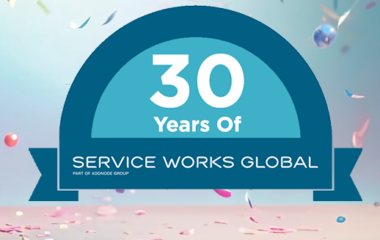Penny Brinsley, Account Director at Service Works Global, discusses with Tomorrow’s Care the implications of facilities management technology in efficient care home estate management including the use of AI to create better maintenance schedules and keep care residents safe.
The UK care sector faces an ever-increasing demand for high-quality services, primarily due to demographic shifts and the growing needs of an ageing population. Care home residents and staff already contend with numerous challenges related to comfort, safety, and human contact.
In this environment, the last thing they should worry about is the state of the care home facilities, whether it’s heating, maintenance, or outdoor spaces. This article explores the significant challenges faced by care homes and the pivotal role that technology, particularly Computer-Aided Facilities Management (CAFM) systems, can play in transforming care estate management. It also outlines the potential of artificial intelligence (AI) for predictive maintenance, offering practical advice and insights that will help building managers in their day-to-day roles, all with the end goal of ensuring a safer environment for all occupants.
Challenges in the Care Sector
A recent Savills report found that there are 3.4 million people in the UK aged over 80 years and approximately 455,000 care home beds. It also reported that the number of people aged over 80 will increase by 32% in the next decade. While not every one of these people will require a care home bed, it does signal that a sector already under strain is likely to see demand increase.
This growing demand is further heightened by the ongoing issues surrounding maintenance and asset management. Care homes can be large and complex facilities that require meticulous attention to detail, both in terms of infrastructure and equipment.
It’s also widely believed that buildings converted into care homes, rather than purpose-built care homes, create additional challenges for facilities teams around maintenance and compliance.
Maintaining the physical infrastructure of care homes is no small feat. Maintenance tasks can range from simple repairs to complex system upgrades. Ensuring that residents are comfortable and safe is essential, but it is equally important to ensure that the premises and its assets are functional. In the winter months, this task becomes even more challenging, as cold weather can take a toll on heating systems, and outdoor areas may require regular gritting and maintenance. Poorly maintained estates can result in subpar or even unsafe living conditions, which can jeopardise the quality of care provided. On top of this, non-compliance can lead to fines for operators, resulting in large business costs. In a nutshell, a well-managed estate is critical for all aspects of a care home.
The Role of Technology in Care Home Estate Management
CAFM systems are a valuable tool in the management of care home estates. They offer a range of features that can revolutionise the way care homes handle maintenance, asset management, and visitor services. Some of the key functionalities that CAFM systems bring to the table include:
Reactive and planned maintenance scheduling: CAFM systems enable care estate managers to schedule and track maintenance tasks efficiently. This ensures that essential maintenance is carried out promptly, minimising disruptions for residents.
SLA and multi-contract management: Care homes often have multiple service contracts with suppliers. CAFM systems help to streamline these contracts, ensuring that service providers are aligned with appropriate deliverables and allowing for better cost control.
Asset lifecycle management: CAFM systems track the lifecycle of assets, allowing care homes to plan for replacements or upgrades, thus reducing the likelihood of equipment breakdowns. Systems can also include maintenance history and warranty documents so that engineers have a full overview of the asset and component parts, to support maintenance tasks.
Self-service for residents and contractors: Providing residents and contractors with self-service options simplifies requests and reporting, making it easier to address issues promptly.
Visitor check-in services: Modern CAFM systems can facilitate visitor check-in, which is a very handy tool in care home settings. These systems help in recording visitor data while enhancing the security of care homes.
Mobile apps for easy access: Mobile apps offered by CAFM systems give operatives and contractors access to critical asset and building information on the move, from any location, improving the efficiency of operations.
When a CAFM system is utilised to its full extent, the benefits extend far beyond the facilities management team. A well-run estate is more efficient, costs are reduced, occupants and visitors have a better experience, and the care home is a safer place.
AI for Predictive Maintenance
The integration of AI into CAFM systems takes facility management to the next level by harnessing machine learning to power predictive maintenance. This enables estate managers to be much more strategic about how they maintain their assets. It can also help to vastly reduce costs and increase an asset’s lifecycle.
For example, AI-enabled FM software can predict and prevent breakdowns by analysing historical data on past asset failures, services, and maintenance. So instead of assets being manually checked on a set schedule, operatives only need to spend time and resources on an asset when necessary. FM teams can use their time more productively, estate budgets are more accurate, and unnecessary journeys are reduced, creating a carbon saving.
AI can also give CAFM users reminders on estate safety requirements. For example, AI can monitor weather conditions and alert users when outside grounds should be gritted ahead of icy weather. This again removes the guesswork for FMs and means they are only gritting when necessary.
Additionally, AI can integrate with other building systems, such as HVAC and lighting, to optimise their operation. The smart running of these systems means they will only operate when required, reducing energy usage. This is not only an environmental benefit, it’s also a cost benefit too in the current climate of high energy prices. This proactive approach reduces asset downtime, lowers maintenance costs, and ensures the uninterrupted functioning of critical systems in care homes.
Next Steps Towards Smart Estate Management
CAFM systems enhanced with AI functionality have the potential to transform care estate management in the UK. By addressing the challenges related to maintenance and asset management, care homes can provide a safer and more comfortable environment for their residents.
However, the implementation of technology needs to be strategic, and its use should align with the overall operational goals of an estate. Important factors to consider include:
Integration: CAFM systems should align with existing processes (with the capability to offer efficiencies) and where necessary, be able to integrate with other organisational systems to avoid disruption; ensure this is the case before making any purchases.
Training: Proper training is essential to ensure that all system users and stakeholders are comfortable using the technology. This includes building managers and care home staff.
Data security: Robust data security measures are crucial to maintain trust and compliance.
Regular updates: Keep the technology up to date to benefit from the latest features and security enhancements.
While it is essential to address the challenges in the care sector, it is equally important to embrace innovative solutions and best practices, ultimately leading to better care and improved quality of life for residents. Care homes are central to the well-being of many in the UK, and the potential of technology to support their operations opens a path to a brighter future for the ageing population.








